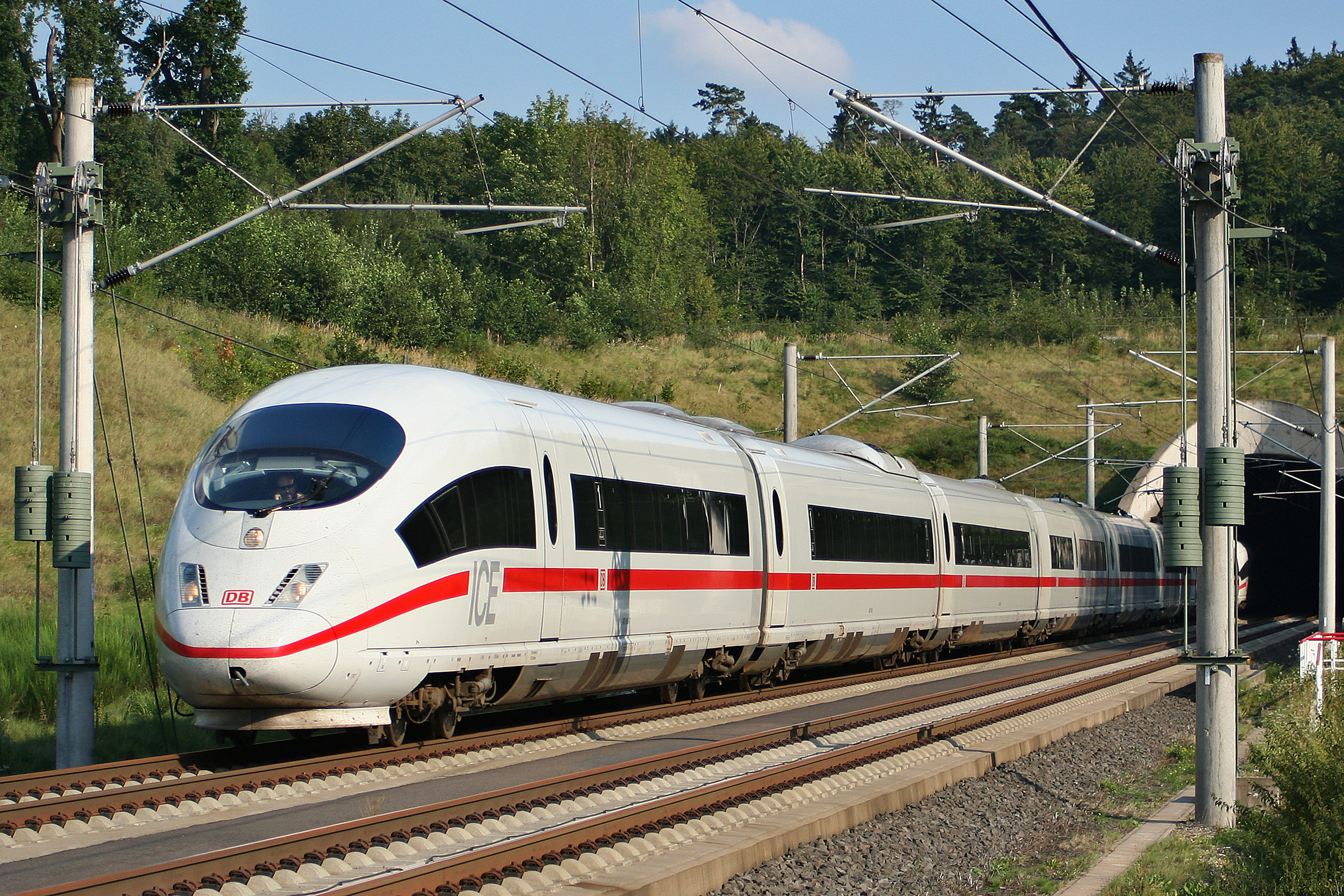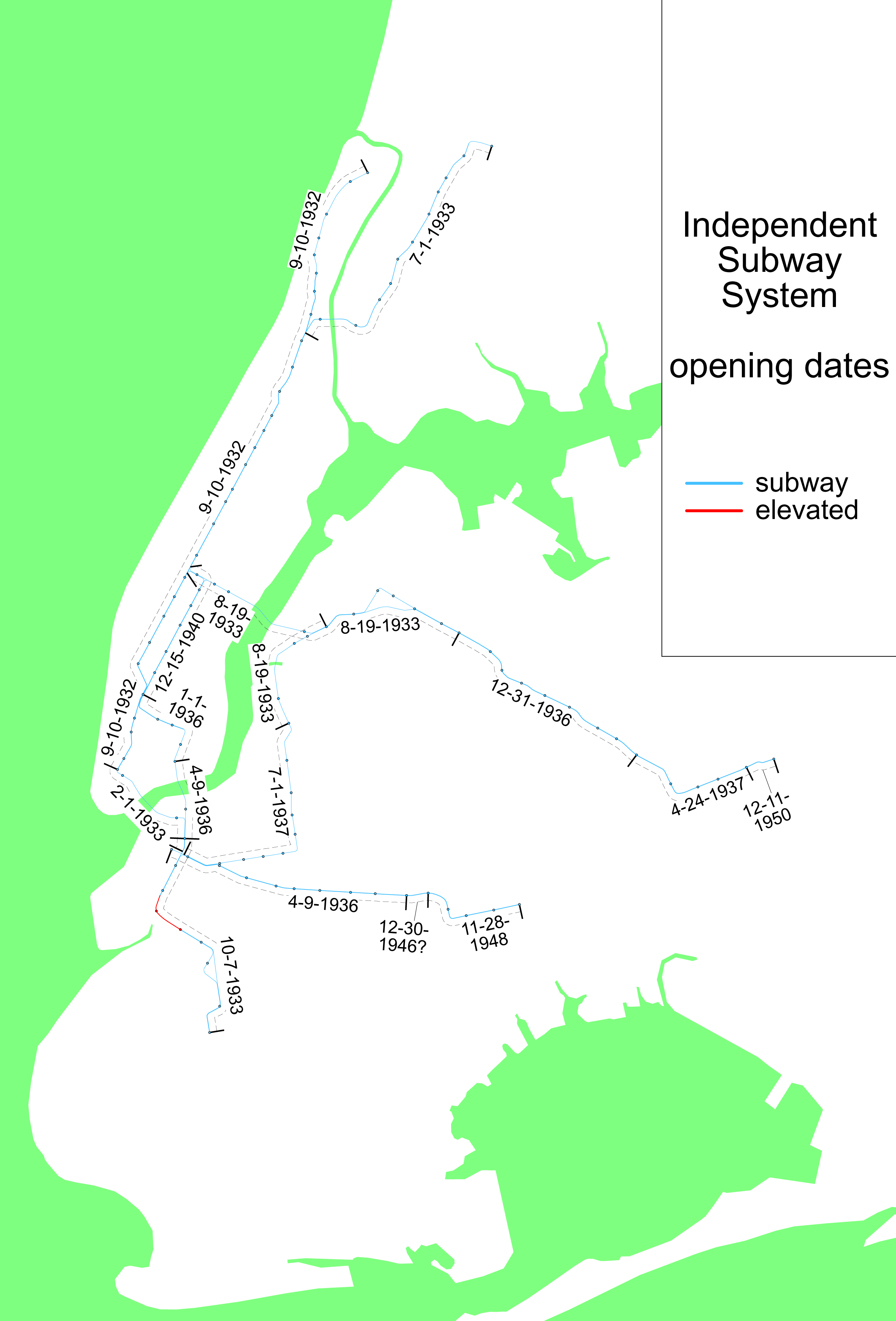|
Bluebird Compartment Car (New York City Subway Car)
The Bluebird, formally dubbed Compartment Car by its purchaser, the Brooklyn–Manhattan Transit Corporation (BMT), was an advanced design PCC streetcar-derived subway and elevated railway car built by the Clark Equipment Company from 1938 to 1940 and used on the New York City Subway system from 1939 to 1955. A total of six units were built, with one prototype and five production units. They were among the last cars to be ordered by the BMT before the city takeover in 1940. The cars were designed to operate on both elevated and subway lines; its lightweight design allowed it to run on the oldest elevated lines without the need to upgrade them to handle heavier cars, while its aluminum alloy body also allowed it to run in the newer subway tunnels, where wooden cars were strictly prohibited. The prototype Bluebird entered service in 1939. While the BMT ordered 50 production Bluebirds, only five were built, due to the New York City Board of Transportation cancelling the order whe ... [...More Info...] [...Related Items...] OR: [Wikipedia] [Google] [Baidu] |
BMT Bluebird Compartment Car
BMT or bmt may refer to: Transportation * Brooklyn–Manhattan Transit Corporation, one of the three original New York City Subway systems * IATA code and FAA location identifier for Beaumont Municipal Airport, Beaumont, Texas * Station code for Beaumont (Amtrak station), Beaumont, Texas * Station code for Bedminster railway station, Bristol, England Science or technology * Bone Marrow Transplantation, Hematopoietic stem cell transplantation * "best medical therapy", in medicine a term used to point to the best drug treatment according to the current standards * 5-hydroxyfuranocoumarin 5-O-methyltransferase, an enzyme * Bangladesh Meteorological Department, the national meteorological organization of Bangladesh * Barcelona Moon Team, a Spanish Google Lunar X-Prize competitor Other * Basic Military Training in some military forces * BMT Limited, a British consulting company * Benton MacKaye Trail, a footpath in the Appalachian Mountains * Biel Mean Time, a decimal ti ... [...More Info...] [...Related Items...] OR: [Wikipedia] [Google] [Baidu] |
Streetcar
A tram (called a streetcar or trolley in North America) is a rail vehicle that travels on tramway tracks on public urban streets; some include segments on segregated right-of-way. The tramlines or networks operated as public transport are called tramways or simply trams/streetcars. Many recently built tramways use the contemporary term light rail. The vehicles are called streetcars or trolleys (not to be confused with trolleybus) in North America and trams or tramcars elsewhere. The first two terms are often used interchangeably in the United States, with ''trolley'' being the preferred term in the eastern US and ''streetcar'' in the western US. ''Streetcar'' or ''tramway'' are preferred in Canada. In parts of the United States, internally powered buses made to resemble a streetcar are often referred to as "trolleys". To avoid further confusion with trolley buses, the American Public Transportation Association (APTA) refers to them as "trolley-replica buses". In the United ... [...More Info...] [...Related Items...] OR: [Wikipedia] [Google] [Baidu] |
1938 In Rail Transport
Events January * January 1 – Creation of the following European railway networks under government control: ** SNCF (Société Nationale des Chemins de fer Français), bringing the principal railway companies of France together. ** NS (Nederlandsche Spoorwegen), merging the Hollandsche IJzeren Spoorweg-Maatschappij (HSM) and the Maatschappij tot Exploitatie van Staatsspoorwegen (SS) in the Netherlands. * January 22 – The Pacific Electric Whittier Line is truncated to Walker. February * February 22 – The Atchison, Topeka and Santa Fe Railway introduces the ''El Capitan'' passenger train between Chicago and Los Angeles. * February 26 – A second all-lightweight trainset enters service on the ''Super Chief''. March * March 6 – The Pacific Electric Walker Line is discontinued. * March 18 – ''Bundesbahn Österreich'' (BBÖ, Federal Railway of Austria) integrated into Deutsche Reichsbahn. * March 27 – Atchison, Topeka and Santa Fe Railwa ... [...More Info...] [...Related Items...] OR: [Wikipedia] [Google] [Baidu] |
R16 (New York City Subway Car)
The R16 was a New York City Subway car model built by the American Car and Foundry Company from 1954 to 1955 for the IND/ BMT B Division. A total of 200 cars were built, arranged as single units. Two versions were manufactured: Westinghouse (WH)-powered cars and General Electric (GE)-powered cars. The first R16s entered service on January 10, 1955. Various modifications were made over the years to the R16 fleet. The GE-powered cars were found to be less reliable than the WH-powered cars, so the New York City Transit Authority planned to retire them early in 1977 with R46s. However, problems with R46 cars kept the GE-powered R16s in service until 1983. The WH-powered R16s were retired in 1987 with the delivery of the R68s. Some R16 cars were saved for various purposes, but most were scrapped. Description The R16s were numbered 6300–6499. When delivered, the R16s quickly became the new standard in car design for the New York City Transit Authority. Structurally and mech ... [...More Info...] [...Related Items...] OR: [Wikipedia] [Google] [Baidu] |
BMT Fourth Avenue Line
The BMT Fourth Avenue Line is a rapid transit line of the New York City Subway, mainly running under Fourth Avenue in Brooklyn. The line is served by the D, N, and R at all times; the R typically runs local, while the D and N run express during the day and local at night. During rush hours, select W and northbound Q trains also serve the line. Limited rush-hour N trains operate local on the line in the reverse-peak direction. The line was originally built by the Brooklyn Rapid Transit Company (BRT; later Brooklyn–Manhattan Transit Corporation, or BMT) and is now internally operated as part of the New York City Subway's B Division. The fully underground line starts as a two-track line in Downtown Brooklyn west of Court Street, connecting to the BMT Broadway Line and BMT Nassau Street Line in Manhattan via the Montague Street Tunnel under the East River. It travels east under Montague and Willoughby Streets to DeKalb Avenue, where it then turns southeast under Flatbush Aven ... [...More Info...] [...Related Items...] OR: [Wikipedia] [Google] [Baidu] |
BMT Brighton Line
The BMT Brighton Line, also known as the Brighton Beach Line, is a rapid transit line in the B Division of the New York City Subway in Brooklyn, New York City, United States. Local service is provided at all times by the Q train, but is joined by the B express train on weekdays. The Q train runs the length of the entire line from Coney Island–Stillwell Avenue to the Manhattan Bridge south tracks. The B begins at Brighton Beach and runs via the bridge's north tracks. The line first opened in 1878 as a two-track surface-level excursion railroad called the Brooklyn, Flatbush and Coney Island Railway, transporting riders from Downtown Brooklyn via a connection with the Long Island Rail Road (LIRR) to the seaside resorts at Coney Island. When its connection with the LIRR was severed in 1883, the line became the Brooklyn and Brighton Beach Railroad, which was eventually acquired by the Brooklyn Rapid Transit Company (BRT, later Brooklyn–Manhattan Transit Corporation MT. From ... [...More Info...] [...Related Items...] OR: [Wikipedia] [Google] [Baidu] |
BMT Canarsie Line
The BMT Canarsie Line (sometimes referred to as the 14th Street–Eastern Line) is a rapid transit line of the B Division of the New York City Subway system, named after its terminus in the Canarsie neighborhood of Brooklyn. It is served by the L train at all times, which is shown in on the New York City Subway map and on station signs. The line is part of the BMT Eastern Division, and is occasionally referred to as the ''Eastern District Line''. This refers to Williamsburg, which was described as Brooklyn's "Eastern District" when the City of Williamsburg was annexed by the former City of Brooklyn. This was the location where the original Brooklyn subway portions of the line were laid out. Only later was the line connected to the tracks leading to Canarsie. Eastern District High School, near the line's Grand Street station, had preserved this toponym until it was closed in 1996, later reopened as Grand Street Educational Campus. The Canarsie Line was first a steam railroa ... [...More Info...] [...Related Items...] OR: [Wikipedia] [Google] [Baidu] |
BMT Franklin Avenue Line
The BMT Franklin Avenue Line (also known as the Brighton–Franklin Line) is a rapid transit line of the New York City Subway in Brooklyn, New York, running between Franklin Avenue and Prospect Park. Service is full-time, and provided by the Franklin Avenue Shuttle. The line serves the neighborhoods of Bedford-Stuyvesant and Crown Heights, and allows for easy connections between the Fulton Street Line and the Brighton Line. The line was originally part of the Brooklyn, Flatbush, and Coney Island Railway, which was created to connect Downtown Brooklyn with Coney Island. This Franklin Avenue Line opened in 1878 as part of the railway. Trains continued via the Long Island Rail Road to get to Downtown Brooklyn. In 1896, a connection was built with the Fulton Street Elevated, providing direct service to Manhattan. In 1905 and 1906, the line was elevated near Park Place to eliminate the last remaining grade crossings. In 1913, the line was acquired by the Brooklyn Rapid Transi ... [...More Info...] [...Related Items...] OR: [Wikipedia] [Google] [Baidu] |
Multiple Unit
A multiple-unit train or simply multiple unit (MU) is a self-propelled train composed of one or more carriages joined together, which when coupled to another multiple unit can be controlled by a single driver, with multiple-unit train control. Although multiple units consist of several carriages, single self-propelled carriages – also called railcars, rail motor coaches or railbuses – are in fact multiple-units when two or more of them are working connected through multiple-unit train control (regardless if passengers can walk between the units or not). History Multiple-unit train control was first used in electric multiple units in the 1890s. The Liverpool Overhead Railway opened in 1893 with two-car electric multiple units, controllers in cabs at both ends directly controlling the traction current to motors on both cars. The multiple-unit traction control system was developed by Frank Sprague and first applied and tested on the South Side Elevated Railroad (now p ... [...More Info...] [...Related Items...] OR: [Wikipedia] [Google] [Baidu] |
Independent Subway System
The Independent Subway System (IND or ISS), formerly known as the Independent City-Owned Subway System (ICOSS) or the Independent City-Owned Rapid Transit Railroad (ICORTR), was a rapid transit rail system in New York City that is now part of the New York City Subway. It was first constructed as the Eighth Avenue Line in Manhattan in 1932. One of three rail networks that became part of the modern New York City subway, the IND was intended to be fully owned and operated by the municipal government, in contrast to the privately operated or jointly funded Interborough Rapid Transit Company (IRT) and Brooklyn–Manhattan Transit Corporation (BMT) companies. It was merged with these two networks in 1940. The original IND service lines are the modern subway's A, B, C, D, E, F, and G services. In addition, the BMT's M, N, Q and R now run partly on IND trackage. The Rockaway Park Shuttle supplements the A service. For operational purposes, the IND and BMT lines and service ... [...More Info...] [...Related Items...] OR: [Wikipedia] [Google] [Baidu] |
Rapid Transit
Rapid transit or mass rapid transit (MRT), also known as heavy rail or metro, is a type of high-capacity public transport generally found in urban areas. A rapid transit system that primarily or traditionally runs below the surface may be called a subway, tube, or underground. Unlike buses or trams, rapid transit systems are railways (usually electric railway, electric) that operate on an exclusive right-of-way (transportation), right-of-way, which cannot be accessed by pedestrians or other vehicles, and which is often grade-separated in tunnels or on elevated railways. Modern services on rapid transit systems are provided on designated lines between rapid transit station, stations typically using electric multiple units on rail tracks, although some systems use guided rubber tires, magnetic levitation (''maglev''), or monorail. The stations typically have high platforms, without steps inside the trains, requiring custom-made trains in order to minimize gaps between train a ... [...More Info...] [...Related Items...] OR: [Wikipedia] [Google] [Baidu] |
Battle Creek, Michigan
Battle Creek is a city in the U.S. state of Michigan, in northwest Calhoun County, Michigan, Calhoun County, at the confluence of the Kalamazoo River, Kalamazoo and Battle Creek River, Battle Creek rivers. It is the principal city of the Battle Creek, Michigan Metropolitan Statistical Area (MSA), which encompasses all of Calhoun County. As of the 2020 United States census, 2020 census, the city had a total population of 52,731. Nicknamed "Cereal City", it is best known as the home of the Kellogg's, Kellogg Company and the founding city of Post Consumer Brands. Toponym One local legend says Battle Creek was named after an encounter between a Surveyor General of the Northwest Territory, federal government land survey party led by Colonel John Mullett and two Potawatomi in March 1824. The two Potawatomi had approached the camp asking for food because they were hungry as the US Army was late delivering supplies promised to them under the 1821 Treaty of Chicago. After a protracted disc ... [...More Info...] [...Related Items...] OR: [Wikipedia] [Google] [Baidu] |

.jpg)






